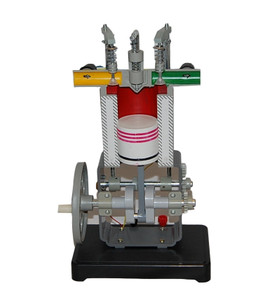This model visually demonstrates how a 4 stroke gasoline engine operates. The user turns a hand crank, which in turn operates a piston. 3 different lights help to visually display what is happening at the various stages of piston travel (intake, spark - air/fuel, exhaust). Requires two AA batteries (not included).. Helps students better understand the four steps required to produce power.
The first step is the intake stroke. In a gas engine, the intake valve opens and the downward movement of the piston draws in a mixture of gas and air.
The second step is the compression stroke, where the piston travels upward and compresses the air/fuel mixture in the cylinder. A term commonly associated with this stroke is the compression ratio, which is the ratio of the volume of the cylinder chamber at the end of intake stroke (the engine has just sucked in the air/fuel mix) versus the volume of the cylinder chamber at the end of the compression stroke (all that air/fuel mix has been compressed into the top end of the cylinder). Compression raises both the pressure and temperature of the air/fuel mix in the cylinder chamber. In a gas engine, the designers must take care not to raise the temperature too high because the air fuel mixture will explode without a spark if it reaches around 250 deg C.
The third step is the power stroke. In a gas engine, the air/fuel mixture is ignited by a spark from the spark plug when the piston reaches the end of the compression stroke. The ignited air and fuel explode and drive the piston downward which transmits power into the crankshaft which in turn drives the wheels of the car and the other pistons through their other strokes.
The fourth and final step is the exhaust stroke. The exhaust valve opens and the piston pushes the spent combustion gases out of the cylinder chamber and into the exhaust system.
Dimensions:
Overall Height: 11.5 Inches / 290mm
Base Dimensions (lxw): 7.5 Inches x 5 Inches / 190mm x 125mm
